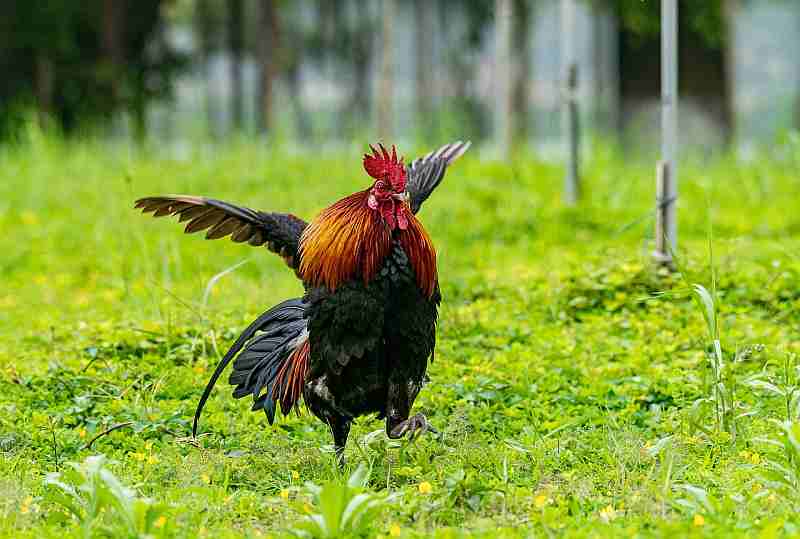Have you ever pondered the Olympic potential of your backyard chickens? You’d be surprised at their vertical prowess. In this deep dive, we’re unraveling how high can chickens jump.
We’ll explore the factors that affect their jumping ability, from physiology to age, and even compare different breeds. So, strap in and prepare to be amazed by the unexpected athleticism of these feathered friends.
It’s time to give your clucking companions the credit they deserve.
Key Takeaways
- Chicken physiology, including their digestive system and feathers, plays a crucial role in their jumping ability.
- Diet, roosting habits, and breed selection significantly influence how high chickens jump.
- The highest recorded jump by a chicken is 10 feet, and factors such as breed, physical condition, and feather quality determine the jumping height.
- Jumping is not only important for survival and predator evasion but can also be improved through training exercises and feather weight management.
Understanding Chicken Physiology
To truly grasp how high a chicken can jump, you must understand some basic aspects of their physiology. Let’s start with chicken digestion. A chicken’s diet, rich in grains and proteins, provides the energy required for muscular activities such as jumping. Their unique digestive system efficiently extracts nutrients, turning them into fuel for muscle contractions.
Now, let’s consider feather functionality. A chicken’s feathers aren’t just for show. They provide lift and help maintain balance during flight. Their feathers can catch the air with a strong downward thrust, allowing chickens to ascend to surprising heights. However, chickens aren’t soaring birds; their flights are brief and more akin to leaps.
Understanding these physiological aspects gives you deeper insight into the dynamics of a chicken’s jump.
Factors Affecting Chicken Jumping
You’ll find that several factors can influence how high your chickens can jump. Two primary ones are the jumping diet and roosting habits.
A balanced jumping diet plays a crucial role. Protein-rich feeds like worms, grains, and insects provide energy for vigorous leaps. Lack of protein can lead to weakened muscles, reducing their jumping capability.
Roosting habits also affect jumping heights. Chickens that regularly roost on higher perches will likely jump higher as they’ve trained their muscles for such feats. In contrast, if your chickens have lower roosts or mostly stay on the ground, they may not develop the required muscle strength for high jumps.
Highest Recorded Chicken Jump
Believe it or not, the highest recorded jump by a chicken is an impressive 10 feet! This feat was accomplished in controlled environments like jumping competitions, where chickens are motivated to reach their maximum potential.
Understanding the technicalities, you’d notice the feather effects at play here. Chickens’ feathers aren’t just for show; they’re designed to assist in lift-off and mid-air balance, which is vital for such high jumps. The feathers act like mini-parachutes, creating air resistance that helps the chicken control its ascent and descent.
In the world of chicken jumping, 10 feet is a significant height. It emphasizes the importance of factors such as breed, physical condition, and feather quality in determining just how high a chicken can leap.
Comparing Chicken Breeds
Let’s compare chicken breeds and their jumping abilities to understand better which can leap the highest.
Breed temperament and feather density substantially determine a chicken’s jumping potential. For instance, agile, active breeds like Leghorns are known for their high leaps due to their light feather density and energetic temperament.
On the other hand, heavier breeds with dense feathers, such as the Brahma, are less adept at jumping due to their weight and calm temperament. Feather density can affect the chicken’s lift, while breed temperament often influences their motivation to jump.
Therefore, when selecting a chicken breed and considering their jumping abilities, these specific factors should be considered.
Impact of Age on Jumping
While you might assume that a chicken’s jumping ability diminishes with age, it’s actually a bit more complex than that. Age progression does affect a chicken’s physical capabilities, yet it’s not a consistent downfall.
Initially, young chicks have limited strength and coordination, imposing jumping limitations. But as they grow, their ability to jump increases, reaching a peak during the prime of their life.
However, old age brings about a decline. Aging chickens face a reduction in muscle mass and joint flexibility, which impairs their jumping capacity. But remember, it’s not a straightforward decrease.
Various factors like breed, health, and diet can influence the impact of age on a chicken’s ability to jump. Therefore, while age affects jumping, it’s not always how you’d expect.
Jumping for Survival: Predators
You mightn’t realize it, but a chicken’s ability to jump can often mean the difference between life and death when confronting predators. This is vital to their predator evasion techniques, springing upwards to confuse or evade the attacker.
It’s not just a random leap but a calculated move, a survival instinct exploration that’s been honed through generations. By studying this behavior, you can observe how the chicken determines the right trajectory and force to escape the predator’s grasp, considering factors like predator speed, size, and approach.
It’s an impressive display of their spatial awareness and physical capabilities. This ability to jump, therefore, serves as more than just a means for reaching higher ground; it’s a crucial survival tool in the face of danger.
Training Chickens to Jump Higher
Despite their innate jumping skills, training your chickens can significantly improve their ability to leap higher. This process involves a combination of jumping exercises and feather weight management.
Begin by setting up a series of low obstacles, gradually increasing their height over time. This technique enhances the chicken’s jumping ability and agility.
Feather weight plays a crucial role in the chicken’s jumping prowess. A lighter feather weight equates to greater lift. Therefore, maintaining your chicken’s feather health and cleanliness is vital. Regular grooming helps to keep the feathers lightweight and aerodynamic, allowing for higher jumps.
Unusual Chicken Jumping Records
After spending plenty of time grooming and training your feathery friends, it’s interesting to look at some of the most unusual chicken jumping records that have been set.
The Chicken Olympics stands out, where jumping competitions often result in astonishing performances.
Once, a bantam hen astoundingly cleared a 3-foot hurdle.
But the record-breaker is a full-grown rooster who managed a heart-stopping jump of over 6 feet.
The biomechanics involved are fascinating: chickens primarily rely on their strong leg muscles rather than wings.
Precision and timing play crucial parts, too.
Frequently Asked Questions
Can Jumping High Affect a Chicken’s Health?
Yes, high jumping can affect a chicken’s health. It could cause jumping stress, potentially harming their feather health. Care should be taken to ensure their environment doesn’t encourage unnecessary high jumps.
Do Chickens Enjoy Jumping, or Is It Purely a Survival Mechanism?
You’re right to question chickens’ jumping motivations. It’s not just survival; chickens display playfulness through jumping. They’re often observed jumping for bugs or simply for fun, showing it’s part of their natural behavior.
How Can I Discourage My Chickens From Jumping Over Fences?
Consider jumping deterrents and fence modifications to discourage your chickens from jumping over fences. Trim their wings regularly, add height to your fence, or install overhangs to prevent them from getting over.
Are There Any Special Diets That Can Improve a Chicken’s Jumping Ability?
No diet will transform your chickens into super jumpers overnight. However, a balanced diet can enhance feather strength and overall health, making jumping exercises more effective. But remember, chickens aren’t natural high jumpers.
Can Chickens Sustain Injuries From Jumping Too High or Too Often?
Yes, chickens can sustain injuries from excessive jumping. The impact can strain their legs and lead to health issues. Monitoring their activity for injury prevention and ensuring a safe environment is crucial.
Conclusion
So, there you have it. Chickens aren’t just your average, clucking yard birds. With the right conditions and training, they can leap into the air, reaching heights that would make an NBA player envious.
From the robust Rhode Island Red to the spritely Bantam, these feathered athletes can jump, dodge predators, and even break records.
So next time you underestimate a chicken, remember – they might just be sizing up how high they can jump over you!

